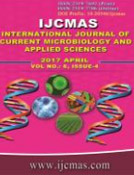


 National Academy of Agricultural Sciences (NAAS)
National Academy of Agricultural Sciences (NAAS)

|
PRINT ISSN : 2319-7692
Online ISSN : 2319-7706 Issues : 12 per year Publisher : Excellent Publishers Email : editorijcmas@gmail.com / submit@ijcmas.com Editor-in-chief: Dr.M.Prakash Index Copernicus ICV 2018: 95.39 NAAS RATING 2020: 5.38 |
An experiment was conducted to study the effect of selective breeding of Japanese quails for improvement of performance. A total of 2765 quails were procured from Poultry Experimental Station as baseline population based on their body weight. Out of which 1850 quails with higher body weights were selected as parents to produce 1200 progeny quail chicks. The overall growth performance such as body weight, body weight gain and feed conversion ratio parameters were recorded weekly intervals till the birds attain six weeks of age, sex wise. The body weight of the progeny (214.09±0.75g) obtained from baseline and selected female quail population (211.72±0.0975g, 213.04±1.233g respectively) was found to be higher than the parental population body weights at the end of the growth period. Similarly, the body weight gain was found to be higher in the progeny (38.68±0.65g) than the parental population (37.72±1.027g, 37.15±0.882g respectively) at six weeks of age. The feed conversion ratio of the progeny ranged from 1.89±0.02 (first week) to 4.73±0.07 (sixth week) which was found to be better feed conversion ratio compared with baseline and selected population during the growth period. The body weight and body weight gain of the progeny (212.88±0.91g and 34.64±0.52g respectively) obtained from baseline and selected male quail population was also found to be higher than the parental population. The FCR of the progeny ranged from first week (2.36±0.04) to six weeks (5.17±0.07) of age. Age at first egg in the flock was 55.79 to 56.53 days and 50% of the birds came to egg production on 59th day. The percentage of hen day egg production was 31.236, 69.911 and 54.812% eggs in 16th, 32nd and 46th week respectively. At the age of 17th to 32nd weeks the hen day egg production reached peak, later the production was decreased.
 |
 |
 |
 |
 |